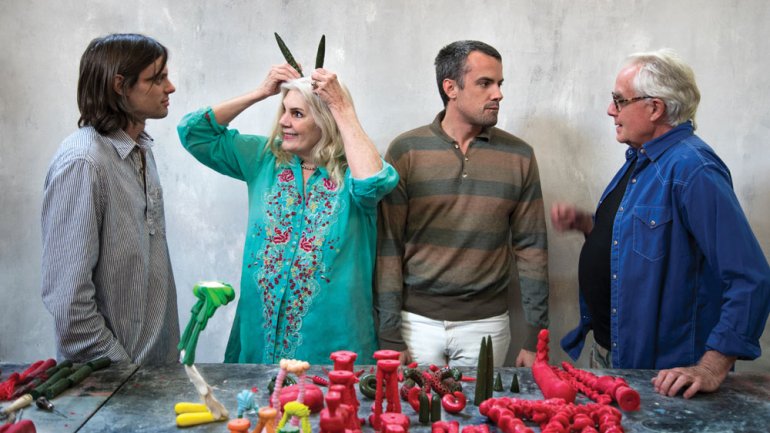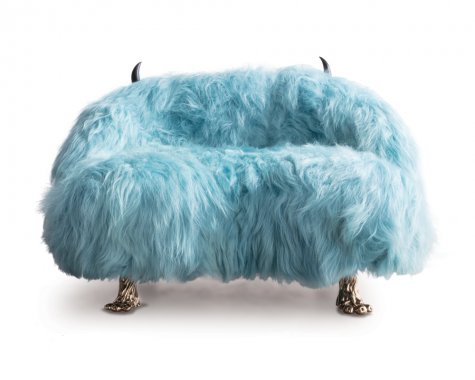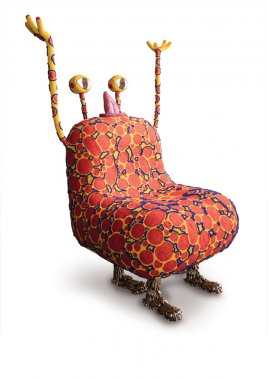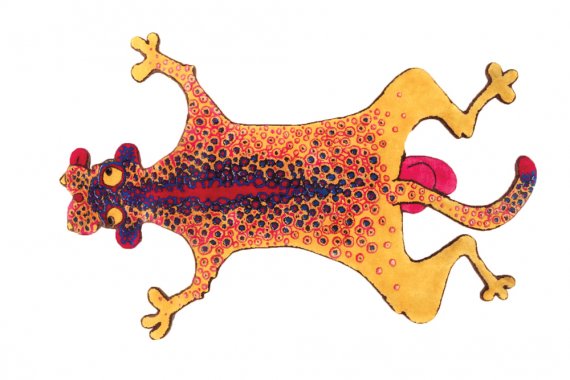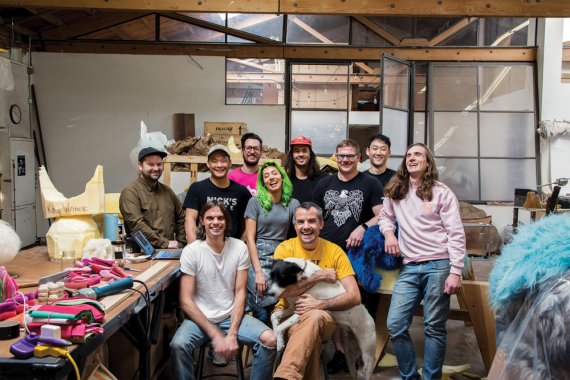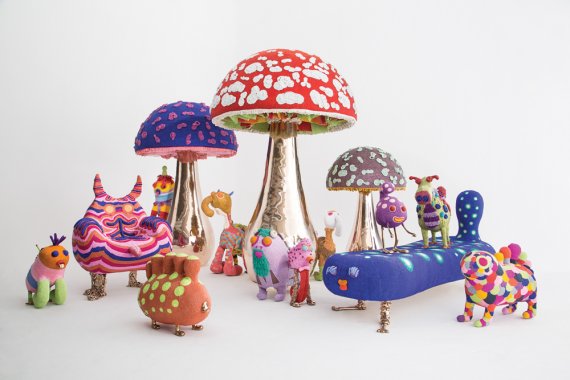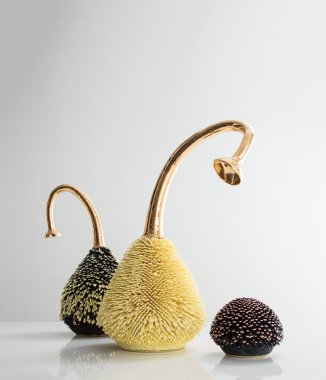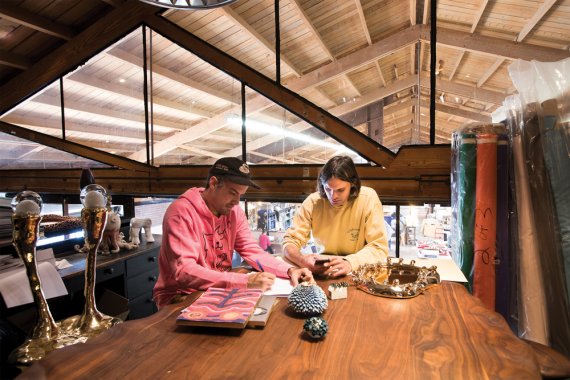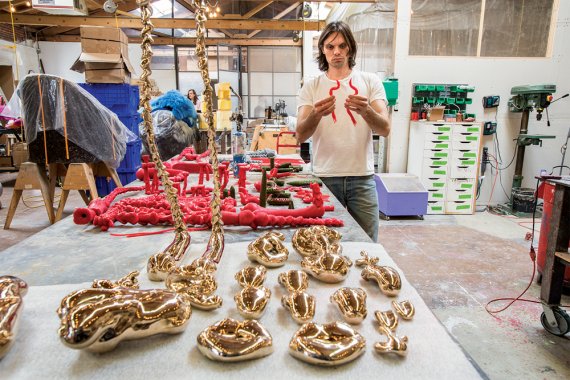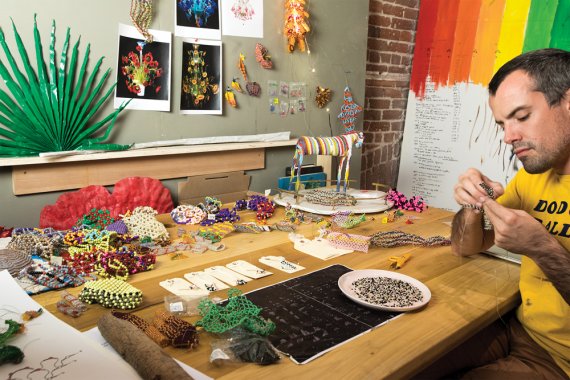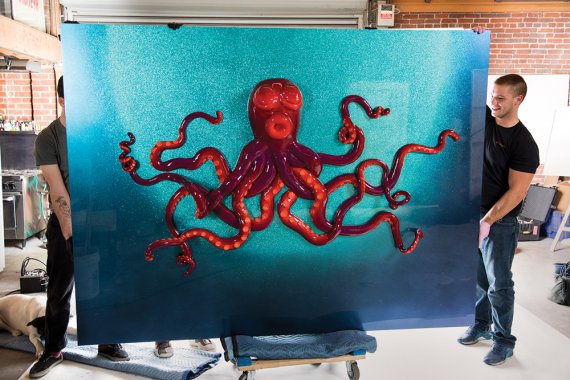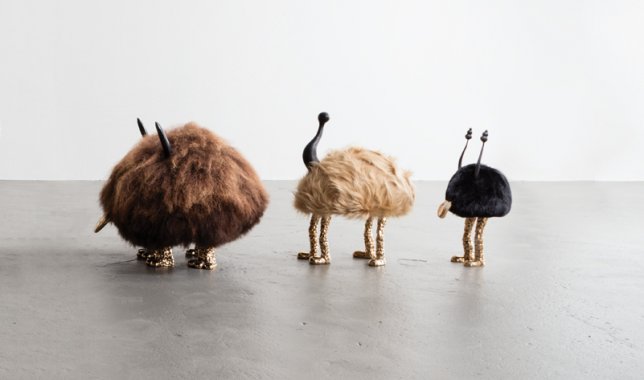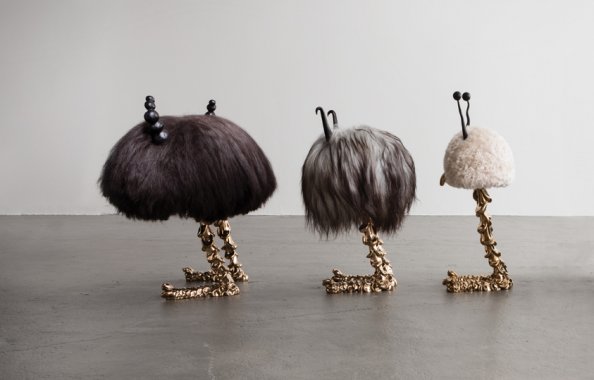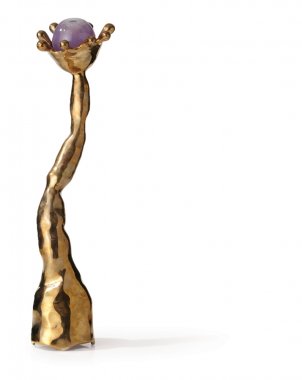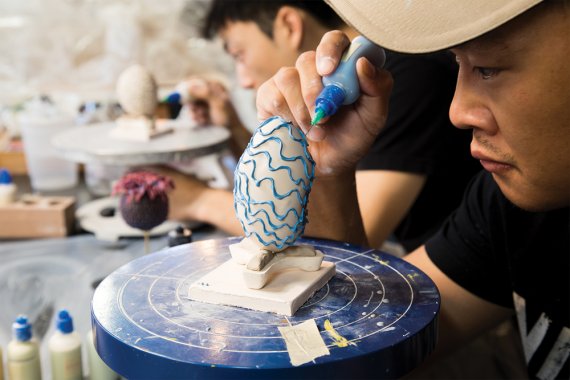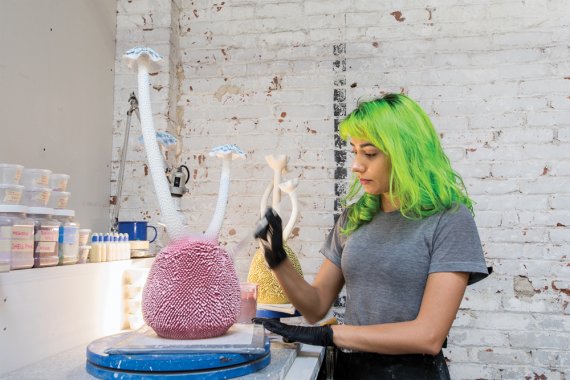A Right-Brained Bunch
A Right-Brained Bunch
Did you happen to buy a tiny, quirky, cartoonish clay creature at a toy store in Austin, Texas, in the early 1990s? If so, you may own a collector’s item. Fraternal twins Nikolai and Simon Haas were just little boys when they made the characters and persuaded the shop to carry them. In retrospect, Simon says, “they actually looked not too far off from what we make now.”
Based in Los Angeles today, the 33-year-old artist-craftsmen – known professionally as the Haas Brothers – are rocking the design world with their eccentric high-end furniture and objects, favored by clients such as Tobey Maguire, Donatella Versace, and Lady Gaga. Their furry horned beasts, strange flora and fauna, and colorful beaded critters have a trippy aesthetic that has drawn comparisons to the work of Peter Max, Maurice Sendak, and Lewis Carroll. Playful and often bawdy – some ceramics have genital openings and protrusions, and a huge hairy ape has literal balls of brass – the pieces are at once endearing and provocative, much like how the brothers see a comedic idol, Howard Stern. “There’s always a point to his crassness,” observes Niki, who enjoys the radio legend’s softer side. And just as Stern smashed boundaries with fearless iconoclasm to become the “King of All Media,” the brothers seize on a myriad of materials with assured proficiency – and a sense of no limits – to realize their bold, fantastical visions.
What accounts for such exceptional creative and entrepreneurial drive? In their case, likely a potent brew of nature and nurture, steeped over generations. Their nuclear family includes older brother Lukas, a star of such films as Witness and Inception; father Berthold, a painter, sculptor and stonemason; and mother Emily, a former opera singer and screenwriter, now a visual artist working with seashells. “We are a very right-brained bunch,” Emily says with a laugh.
For Niki and Simon, growing up Haas meant constantly making things. Everyone in the home tinkered, wrote, performed, played instruments, and did crafts, for fun or work. As kids, the twins would help cook elaborate dinners for the family’s entertainment-industry friends such as Laura Dern and Terrence Malick, then join the adults for lively conversation at the table. In their teens, they built a backyard studio for their mom, as well as a treehouse with a fanciful spiral staircase fashioned from fallen branches they gathered after a storm.
“All of us were always creating stuff, all the time. The funny thing is, our family just treated it in a casual way, like, ‘Oh, yeah, this is how you make things and, you know – duh.’ It was a way of life,” says Niki. He and Simon credit their parents for instilling in them confidence and an exploratory spirit. “They gave us love and encouragement, and always made us feel like we could do anything we wanted, as long as it was positive and good,” he says. “We’ve never been afraid to make something, and that comes from our family, for sure.”
“We supported all creative efforts at all times, but we were equally staunch about understanding materials and being very, very dedicated to crafting things beautifully and consistently, and not leaving out details,” Berthold says of the principles that have grounded the family’s artistic pursuits going back almost a century. Born in 1947, he was raised in the Black Forest region of Germany, where his own father, Siegfried, was a painter and sculptor of ecclesiastical and public commissions. “He was very much a religious artist, traditional, deeply influenced by Renaissance art. After the destruction of the Second World War, there was a desire to find some kind of sense, and going back to older forms was probably his way of doing that,” says Berthold, who worked by his dad’s side from an early age, doing everything from sgraffito painting and wax forming to casting bronze and carving stone. “It was important to understand what materials do, how they operate, and also how to extract a personal expression from them, make them have a feeling, a human dimension. He taught me about texture and tactile experience. It was quite a school, actually.” Berthold went on to study art and architecture at the Academy of Fine Arts in Berlin. There, in 1969, he met Emily, a young Texan with a big voice, who was studying opera on a Fulbright scholarship.
The couple eventually married, and in 1976 they moved to California, where they started their family. After Lukas had his 1985 breakout role as the titular Amish boy in Witness, they left the high-pressure environment of Hollywood and settled in Emily’s hometown of Austin. She became a successful writer for film and TV, balancing work, travel, and motherhood. Berthold built a business on various forms of art, from painting and furniture making to crafting stone walls, grottoes, and fireplaces. Niki and Simon would often hang out in his studio and play with materials. As Berthold says, “I kind of did the same thing with them that my dad had done with me.”
After high school, Simon attended Rhode Island School of Design before dropping out, while Niki played in a band in New York. In 2007, determined to work together in some creative capacity, the pair went to LA, where Lukas was part of a circle of accomplished musicians and actors such as Leonardo DiCaprio. “We watched all of them have very successful careers doing exactly what they wanted to do,” says Simon. “We were able to observe and understand the exact kind of attitude that allowed them to turn their craft into a sustainable living.” In 2010, Tobey Maguire hired the twins to renovate his office and make some furniture, and their careers took off. The next big break came in 2013 with a commission from Donatella Versace, head of the iconic fashion house. Asked to design a chair for her, the brothers also proposed “shoes and accessories and prints and all kinds of stuff”; on the spot, she placed a big order for Versace Home. “That’s really almost the biggest key to our success – putting a lot of enthusiasm forward,” says Niki. “Our excitement gets other people excited. We get more excited. And then the project gets big and better and cooler.”
That philosophy extends to the vibrant, familial environment they maintain for the creative team at their 3,500- square-foot industrial space in the West Adams neighborhood of LA. (Almost every element of their work is made there, except for stone carved in Portugal, some large bronzes cast in Spain, and beading in South Africa.) The 10-member crew works a four-day week (sometimes with breaks for yoga, cooking, and music), leaving the studio open from Friday to Sunday for any of them to use for personal projects. “When people are happy and excited, they make much better work,” Niki says.
While there is an unspoken “twin understanding” between the brothers, each brings his individual viewpoint and strengths to the collaboration. “All of the shapes and energy come from Niki, and many of the processes come from me,” says Simon, whose innovations include a ceramic surface technique that mimics natural accretion, a binary code that uses beadwork to generate three-dimensional forms, and a brass hexagonal grid that serves as a signature coating on some of their pieces. Niki describes their roles in naturalistic terms. “If you’re lying down underneath a tree, looking up through it and being blown away by its divine math and how perfect it is – that’s what Simon puts into the work. If you’re holding a cat and petting it and loving the way it purrs and feeling excited about holding that sweet, fluffy cat, that’s what I’m injecting into it.” As their mother puts it, “From the time they were tiny little guys, they were like the sun and the moon. Such opposites personality-wise, but just a perfect little team.”
For all the irreverent charm of their work, the Haas Brothers aim for deeper meaning in their practice. “Every time we approach a project, it’s in the back of our minds that we have privilege we can share,” Simon says. They collaborated with a women’s beadwork cooperative in South Africa to design and produce the objects in their Afreak series, generating a new market and outlet for those artisans. Ape Suzette (2017), a bronze sculpture they donated to a benefit auction, fetched about $700,000 for AIDS research. Haas for the Holidays, their recent display-window project for Barneys New York, celebrated diversity, kindness, and environmental awareness, and included an Instagram hashtag campaign benefiting the Children’s Defense Fund. When they put forth a socially responsible, positive message, they believe, “everybody wins.”
As for Berthold and Emily, they moved back to LA a few years ago and find themselves enjoying a fresh burst of creativity, encouraged by their sons. Berthold carves all of the wood horns for the twins’ beasts, a job that has inspired him to make his own sculptures in ebony. Emily, now retired from screenwriting, is focused on the shell work that has been her passion for the past decade, crafting walls, fountains, and objects in an exquisite range of shapes, textures, and colors from the sea. And both are elated with their new roles as grandparents: Niki and stylist Djuna Bel had their first child in November.
“The joy that brings is like a circle being completed,” says Emily. “I was so happy when Niki said the other day, ‘The three things I want to teach my son for sure are how to garden, how to be a good cook, and how to be a carpenter – to be able to fix anything or make anything he wanted to make.’ That was lovely to hear,” she says, “because those are the skills you don’t necessarily learn in school. But they’re the basic things you need to have a happy life.”
